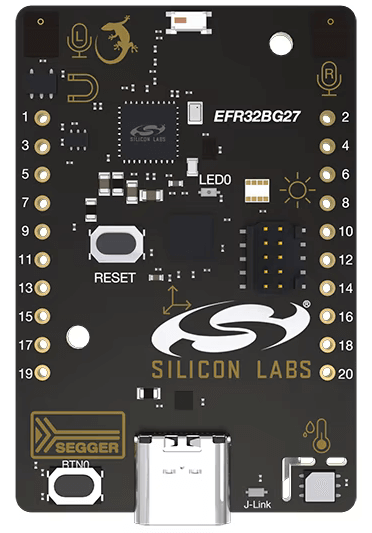EFR32xG27 Dev Kit (xG27-DK2602A)
Silicon Labs xG27-DK2602A is a Dev Kit using the EFR32BG27 SoC. The kit consists of the EFR32BG27 +8 dBm Dev Kit Board (BRD2602A).

xG27-DK2602A (image courtesy of Silicon Labs)
Hardware
EFR32BG27 Blue Gecko Wireless SoC with up to 76.8 MHz operating frequency
ARM® Cortex® M33 core with 64 kB RAM and 768 kB Flash
Macronix ultra low power 8-Mbit SPI flash (MX25R8035F)
2.4 GHz ceramic antenna for wireless transmission
Silicon Labs Si7021 relative humidity and temperature sensor
Vishay VEML6035 low power, high sensitivity ambient light Sensor
Silicon Labs Si7210 hall effect sensor
TDK InvenSense ICM-20689 6-axis inertial sensor
Pair of PDM microphones
One LED and one push button
Power enable signals and isolation switches for ultra low power operation
On-board SEGGER J-Link debugger for easy programming and debugging, which includes a USB virtual COM port and Packet Trace Interface (PTI)
Mini Simplicity connector for access to energy profiling and advanced wireless network debugging
Breakout pads for GPIO access and connection to external hardware
Reset button
CR2032 coin cell holder and external battery connector
For more information, refer to these documents:
Supported Features
The xg27_dk2602a board configuration supports the following hardware features:
Interface |
Controller |
Driver/Component |
|---|---|---|
NVIC |
on-chip |
nested vector interrupt controller |
SYSTICK |
on-chip |
systick |
FLASH |
on-chip |
flash memory |
GPIO |
on-chip |
gpio |
UART |
on-chip |
serial |
Flashing
The xG27 Dev Kit includes an embedded J-Link adapter built around EFM32GG12 microcontroller (not user-programmable). The adapter provides:
SWD interface to EFR32BG27 for flashing and debugging.
SWO trace interface to EFR32BG27 for tracing.
UART interface to EFR32BG27 for console access.
A USB connection to the host computer, which exposes CDC-ACM Serial Port endpoints for access to the console UART interface and proprietary J-Link endpoints for access to the SWD and SWO interfaces.
UART functionality of the adapter is accessible via standard CDC-ACM USB driver present in most desktop operating systems and any standard serial port terminal program e.g. picocom.
SWD and SWO functionality is accessible via Simplicity Commander.
The simplest way to flash the board is by using West, which runs Simplicity Commander in unattended mode and passes all the necessary arguments to it.
If Simplicity Commander is installed in the system and the directory in which commander executable is located is present in the PATH environment variable:
west flashOtherwise, one should specify full path to the commander executable:
west flash --commander <path_to_commander_directory>/commanderIn case several J-Link adapters are connected, you must specify serial number of the adapter which should be used for flashing:
west flash --dev-id <J-Link serial number>
Programming and Debugging
The sample application Hello World is used for this example. Build the Zephyr kernel and application:
# From the root of the zephyr repository
west build -b xg27_dk2602a samples/hello_world
Connect your device to your host computer using the USB port and you should see a USB connection. Use west’s flash command
Open a serial terminal (minicom, putty, etc.) with the following settings:
Speed: 115200
Data: 8 bits
Parity: None
Stop bits: 1
Reset the board and you should be able to see on the corresponding Serial Port the following message:
Hello World! xg27_dk2602a